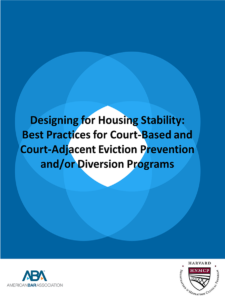 A major new report jointly released today by the Harvard Negotiation and Mediation Clinical Program and the American Bar Association identifies a list of key considerations for designing court-based and court-adjacent eviction prevention and/or diversion programs.
A major new report jointly released today by the Harvard Negotiation and Mediation Clinical Program and the American Bar Association identifies a list of key considerations for designing court-based and court-adjacent eviction prevention and/or diversion programs.
The report, Designing for Housing Stability: Best Practices for Court-Based and Court-Adjacent Eviction Prevention and/or Diversion Programs, was written by HNMCP Clinical Instructor Deanna Pantín Parrish, with research support from students in the Dispute Systems Design Clinic during the Spring 2021 semester, Julian Huertas GSD ’21 and Daniel Nissimyan GSE ’21.
This project assessed court-based and court-adjacent eviction prevention and/or diversion programs across the United States in order to understand what programmatic features or interventions have successfully reduced filings and evictions. To pursue these questions, the HNMCP team engaged over 320 stakeholders from diverse sectors—legal, policy, eviction prevention and/or diversion programs, and government—through individual interviews, focus groups, comprehensive surveys, and direct observation. HNMCP engaged in this research with support from the ABA’s Task Force on Legal Needs Arising From the Coronavirus (COVID-19) Pandemic.
Key findings of the assessment include:
- Stakeholders across sectors have multiple metrics of success for achieving the goal of “eviction prevention.” Notably, landlords and tenants both include “housing stability” in their definitions.
- There is widespread buy-in for eviction prevention efforts across stakeholders, likely amplified by the financial and political pressures of the COVID-19 pandemic.
- Eviction prevention and/or diversion efforts are widespread, especially outside of formal state and county designations. This suggests that informal relationships, networks, and resources are in place to easily formalize and expand eviction prevention programs.
Parrish, the author of the report, remarked, “Our research asks how courts and communities can design interventions that help prevent and divert evictions. Data shows that investment in eviction diversion is both urgent and widely supported. Moreover, it’s doable: informal efforts are widespread, suggesting that the networks and resources are in place to easily formalize and expand eviction prevention programs across the United States.”
These findings informed the development of a checklist of key considerations for any court or community to consider in the design, implementation, and operation of an eviction prevention and/or diversion program. These key considerations include:
- Who will be involved in the design, implementation, and support of the program?
Programs should be designed with input from tenants and landlords, among others; implemented by coalitions of multisectoral actors expert in the parties’ human needs, legal needs, and financial needs; and championed and formalized by judicial and legislative decision-makers.
- What services, resources, and processes will the program include?
Programs should employ a holistic approach to eviction diversion, and should include some combination of at least two of the following: rental or cash assistance; access to legal representation; quality mediation; and self-help resources.
- When in the eviction process will this intervention take place?
Upstream interventions, especially those that occur at the pre-filing stage, more efficiently divert cases away from court and connect parties to resources that help prevent evictions.
- How will the program center its users (tenants and landlords)?
Wherever possible, programs should seek to maximize party agency; protect party privacy and legal records; and collect feedback and long-term impact measurements.
The report expands on each of these considerations with specific data and quotes, drawn from interviews with and surveys to property owners and tenant-aligned stakeholders, in support of particular approaches.
Emily Benfer of the ABA’s Task Force on Legal Needs Arising From the Coronavirus (COVID-19) Pandemic shared, “With the expiration of the CDC moratorium imminent, millions of families across the country are threatened with eviction and increased risk of the COVID-19 infection and death. Eviction diversion programs offer an evidence-based approach to prevent housing displacement, homelessness, and long-lasting harm for all parties. The Harvard/ABA Report is a timely and invaluable resource for securing housing stability and protecting the health and well-being of communities across the country at this critical moment.”
Designing for Housing Stability serves as a vital step in research supporting effective policy and practice for eviction prevention and/or diversion programs. We hope that this project can help to inform the work of countless stakeholders across the country who are working to enhance housing stability during this time of deepest need.








